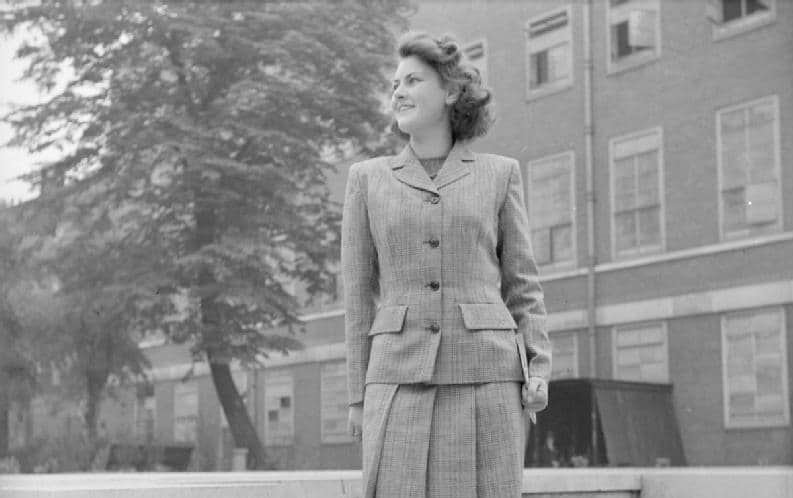British fashion trends in the 1940’s were heavily influenced by the Second World War. Not only because of the mood of the nation, but also because certain materials were incredibly hard to find. Factories and their workers were taken over for making uniforms instead of civilian clothes, wool was prioritised for uniforms and silk for parachutes. Even nylon was reserved for military use only. Natural rubber became increasingly difficult to import and synthetic rubber was yet to be discovered, along with many of the synthetic clothing fibres we use today.
Inevitably, clothes rationing began in June 1941. But even if you had spare coupons, there was no guarantee that the item of clothing you needed would be available in the shops. Or that it was within your budget. Inflation on clothing doubled during the early 1940’s, with luxury items like fur very heavily taxed.
All of this influenced social attitudes towards clothing and fashion. For women – hats and gloves were no longer required, with stockings kept for best. Hem lines shortened to save fabric. Simpler, fuss free designs also caught on as ruffles and embroidery were viewed as wasteful.
Still controversial in the 1920’s and 30’s – trousers became a more acceptable clothing choice for women. First as part of their uniform provision, then as part of their everyday wardrobe. Women of all ages loved the sense of freedom and practicality that trousers gave them, though some echelons of society continued to be critical of this unladylike trend.
Shortages also heavily influenced men’s fashion of the era. Suits remained a mainstay of male attire, made from wool mixed with synthetic rayon. Styles became more subdued, in muted tones of grey, black or brown. Single breasted jackets used less fabric, turn ups vanished. For business and special occasions, shirts retained their collar. Rounded club collars made an appearance, but the real trendsetters wore a sharp, pointed collar called the Spearpoint. Popular accessories included cufflinks, braces and a wide brimmed fedora. For more casual day wear the shirt could be collarless, worn under a knitted tank top instead of a jacket.
As with food rationing, the government launched a public campaign to keep morale high. They saw that magazines could be a useful way of sharing information with women. Working in conjunction with fashion magazines such as Vogue, they promoted a make do and mend attitude, and espoused the benefits of buying their Utility Clothing created in conjunction with British fashion designers. Articles encouraged women to try one of the shorter, but nevertheless glamorous hairstyles, and looked forward to a time when rationing came to an end.
Finally, in 1947, Christian Dior made waves in the fashion world with his first collection named the ‘New Look’. In contrast to the masculine, pared down look of the war years, Dior presented a selection of designs featuring rounded shoulders, cinched waists, and full skirts. Clothing rationing remained in force until 1949, but the New Look was greeted with great excitement, leading women’s fashion back to a more feminine approach. Despite this, the social attitudes to women’s clothing and appearance had changed forever, and can still be seen today in the way that women of all ages dress for work, leisure and fun.
